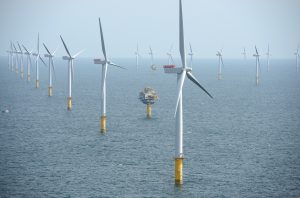 Offshore wind is not yet easy to build in the United States. But with offshore wind prospects looking bright, the question is no longer if a boom will happen, industry stakeholders say, it is when and how it will happen. However, policy follow-through will be a critical component of this growth, along with improving economics and other factors.
Offshore wind is not yet easy to build in the United States. But with offshore wind prospects looking bright, the question is no longer if a boom will happen, industry stakeholders say, it is when and how it will happen. However, policy follow-through will be a critical component of this growth, along with improving economics and other factors.
While the U.S. had only one of the world’s 111 operating offshore wind projects as of the end of 2016, global developers are still setting up shop. Of the estimated 231,000 MW of potential capacity in the global development pipeline at the end of 2016, 10% is slated for the U.S. Falling prices and new state policies mandating more renewables are the two key reasons that the offshore wind industry is coming to America.
But what is responsible for this pending boom? The commissioning of the Block Island Wind Farm gave the domestic industry a significant boost. Additionally, multiple studies have shown that floating offshore wind prices are on the same cost reduction trajectory as fixed offshore wind and that economies of scale will drive prices lower still. Finally, siting and technology advances promise higher productivity.
Experts point out that while states have made policy commitments, follow-through is needed so that the market can do its job and ensure a continued pipeline of competitive projects. Actions, such as codifying governor Cuomo’s call for 2.4 GW of offshore wind by 2030 or ensuring the actual implementation of laws such as New Jersey’s 2010 1.1 GW mandate are needed to encourage investors. Market certainty will in turn encourage technological innovation and attract the supply chain necessary to support the growing industry. East Coast conditions are comparable to Northern Europe and can support the developing market but political support is needed.
Adapted from an article originally published by UtilityDive on August 30th.
One has to be cautious about using the Block Island, R.I. experience to support further investments in offshore wind power. First, the five 6 MW wind turbines do not actually provide… Read more »
Offshore Wind has great potential to generate clean energy. The majority of cities are along the coast.and since the wind blows day and night. It is interesting to note #WSJ recognize… Read more »
Offshore wind development in the US is a lurid example of the triumph of public relations over reality, in a form which severely compromises the real ;prospects for renewable energy… Read more »
I have been an advocate for East Coast offshore wind for 6+ years, East Coast because the continental shelf from Cape Cod to Cape Hatteras has uniquely suited geology for… Read more »
In this thread, three questions are posed. They are: 1. What are the barriers to political follow-through and how may they best be addressed? 2. How can state policies continue… Read more »